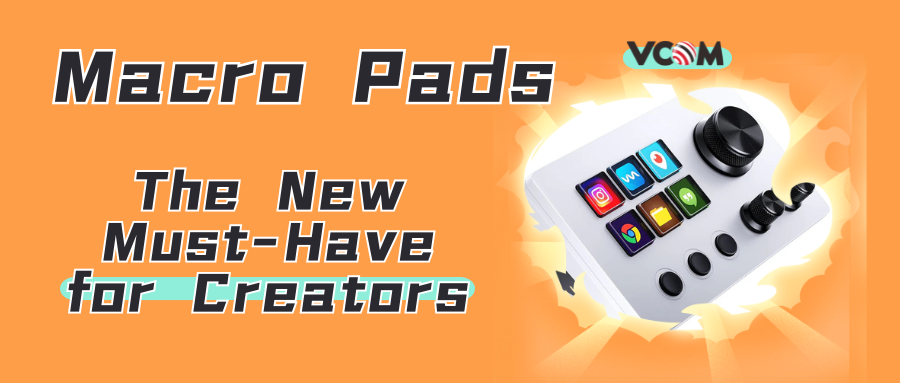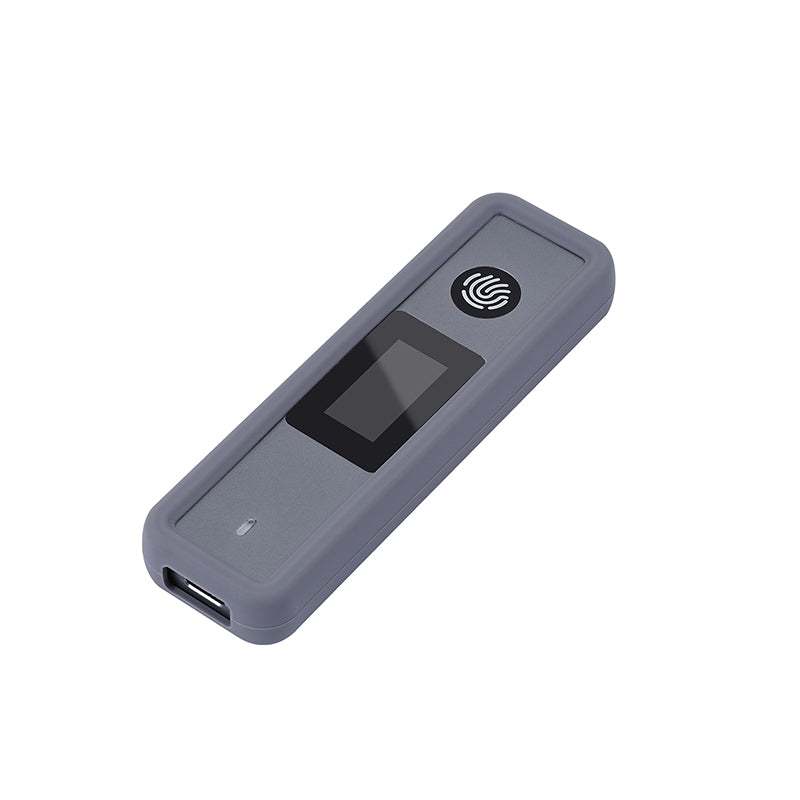
Share
Why Modern Creators Are Switching to Macro Pads for Video, Design, and Sound
The Creator’s Workflow Revolution
Why do so many editors, designers, and musicians seem obsessed with macro pads lately? In today’s fast-paced creative industries, workflows are jam-packed with repetitive tasks: video editors trim and color-grade clip after clip, graphic designers toggle layer visibility and tool settings, and music producers loop and mix countless tracks. All those keyboard shortcuts, mouse clicks, and menu dives can slow you down and interrupt the creative flow. That’s why creators are looking for a natural, intuitive control center to boost productivity and cut stress.
A macro pad may seem like a simple gadget at first glance, but it can transform chaos into harmony on your desk. Instead of memorizing dozens of keyboard shortcuts, you get a small panel of customizable keys or dials to execute the same commands in one click. Think of it as a creative control deck – not just another peripheral, but a direct extension of your hands and eyes. With the right macro pad, repetitive sequences can be automated, freeing your brain to focus on bigger ideas. In short, it’s about working smarter, not harder, and staying in flow.

What a Macro Pad Really Brings to the Table
A macro pad is essentially a customizable mini-keyboard. Each button or control can be programmed to perform one or more actions – from a single “cut” in a video to an entire macro that switches layers, applies filters, and exports a file. Compared to traditional keyboard shortcuts, macro pads offer some big advantages:
-
Clear, Dedicated Controls: Unlike an overflowing keyboard where shortcuts can overlap or be forgotten, a macro pad’s keys are labeled and dedicated. You can even attach custom icons or color codes to each button. This tangible feedback means you always know what you’re about to trigger, reducing mistakes and ramp-up time.
-
Visual Feedback: Many macro pads like the VCOM MBox N3 feature RGB backlit keys. Each key’s color can indicate its function or state (armed, recording, editing). In a dark editing studio or during busy timelines, that glow guides you to the right command without hesitation.
-
Efficiency and Customization: You can tailor a macro pad to your exact needs. Want “Export” and “Save” buttons side by side? Done. Need a knob to scrub through the timeline or adjust brush size? That’s easy too. This level of shortcut mastery lets you design your own workflow controls from scratch.
-
Feels Like a Control Deck: More than just a shortcut aggregator, a macro pad becomes a creative control deck at your fingertips. Instead of wrestling with nested menus or complex hotkeys, the pad presents your most-used tools physically. It’s the difference between fumbling for hidden commands and having a smooth, tactile command center.
By addressing the limitations of keyboard shortcuts – confusion, lack of feedback, and static layout – macro pads open the door to a more fluid creative process. In practice, this means less friction and fewer interruptions, whether you’re slicing video footage, painting a digital illustration, or adjusting a live audio track.
Video Editing: Precision and Flow
For video editors using Premiere Pro, DaVinci Resolve, Final Cut, or similar tools, timing and precision are everything. Macro pads like the MBox N3 let you perform common editing tasks with lightning speed. Imagine hitting a button to cut a clip, another to zoom the timeline to the perfect range, and a third to jump to your next marker. You can even map a key to export your final sequence without touching a mouse. Cut, Trim, and Export — All Without Touching Your Mouse. Color-coded, backlit keys on the MBox N3 mean your “Cut” button might glow red, while “Play/Pause” glows green and “Zoom In/Out” glows blue. This visual language lets you jump through your edit with confidence, even in dimly-lit editing bays. The built-in USB-C connection provides instant response, so pressing “Trim” or “Undo” happens immediately. There’s no lag between intent and action, which is crucial when you’re on a tight deadline.
Consider the busy creative professional cutting a feature-length film. Instead of straining to remember Ctrl+K or Option+X, they simply press the dedicated key. They no longer need to click a tiny on-screen button or navigate menus mid-conversation with a director.
The MBox N3’s mechanical keys deliver satisfying feedback with each press, making the edit into a rhythmic process. In practice, this translates to smoother, faster editing sessions. The time saved clicking and typing can now be spent on creative decisions, refining the story, or polishing the final cut.
A freelance video editor noted recently: “Having all my favorite shortcuts under my fingertips is a game-changer. Once I mapped my tools to the MBox N3, I couldn’t go back to just a keyboard.” — Video Editor, 2025. By automating the tedious parts of the edit, she says, editors stay in “the zone” longer. That means more time for creativity and storytelling.
Design and Animation: Shortcut Mastery
Graphic designers, digital artists, and animators live in software like Photoshop, Illustrator, and After Effects. These programs are powerful but packed with hidden features. With a macro pad, those features suddenly become accessible with one press. Need to toggle layer visibility or switch blend modes? Map them to dedicated keys. Want a physical knob to fine-tune brush hardness or rotate the canvas? It’s possible.

With a macro pad, workflow tweaks become intuitive. “Imagine sliding a finger on the MBox N3’s turn wheel to zoom an image or scrub through your animation timeline,” says a motion graphics creator. Combined with a button press to confirm the zoom level, it’s more intuitive than clicking tiny on-screen icons. Auto-switched profiles on the MBox N3 mean your Photoshop setup can give way to an After Effects layout the moment you switch apps. Each software can have its own set of macros and colors, so you never have to rebuild or reassign functions when you start a new project.
Consider a digital artist jumping between tools. In Photoshop, one set of keys controls brush size, opacity, and color adjustments. In Illustrator, the same pad reprograms on-the-fly for zooming, selecting layers, and snapping objects. This cross-app workflow automation means the creative rhythm isn’t broken by tedious reconfiguration, and you stay focused on the art.
Designers are visual thinkers – their tools should reflect that. That’s why RGB lighting and customizable key legends matter so much. A yellow key for “Pan Tool” and a purple key for “Brush Tool” makes the interface almost self-explanatory. You literally see what your hands are about to do before you do it. “It’s like having a mini-control panel right next to me,” says Graphic Designer, 2025. “I can feel the difference when a tool feels as intuitive as my eyes need it to be.” When everything is this intuitive, the focus stays on creation, not fumbling with tools.
Music Production: Feel the Beat, Not the Lag
For music producers and sound designers working in Ableton Live, Logic Pro, FL Studio, or similar DAWs, timing is king. Playing an instrument or mixing a track becomes more dynamic with a macro pad. The MBox N3 shines in these environments by syncing with the music. Its keys can pulse or change color on the beat. Imagine your mute, solo, or record buttons lighting up perfectly in time with the track, giving you instant visual feedback on the groove you’ve built.
Every typical studio action can be offloaded to the macro pad. Want to start recording? Hit the record button. Need to slice a loop right at the playhead? There’s a key for that. Need to quickly toggle the metronome or switch tracks? Another key. Producers love the tactile control a macro pad affords: a satisfying click instead of hunting through nested menus or tiny on-screen buttons. And crucially, the low latency USB-C connection means those inputs register immediately.
Your fingers and the beat feel in sync, as if they’re one and the same.
The rotating knob becomes a hands-on slider for volume or filter cutoffs. Imagine twisting it to sweep a filter in real time while dropping out a drum loop with a button – it turns digital production into a true performance. In live settings, the pad’s rugged build and portable size mean it can sit right on stage or in a studio setup without worry.
“After I programmed my loops to the MBox keys, it felt like an extension of my drum machine,” says Music Producer, 2025. “The lights pulsing to the BPM keep me locked into the groove.”
Why Creators Prefer the VCOM MBox N3
So, with lots of macro pads on the market, why do creators gravitate toward the VCOM MBox N3? Simply put: it’s built by and for creatives. Here are the main reasons:
-
Plug-and-Play Setup: The MBox N3 connects via USB-C and is recognized instantly by most modern computers. There’s no complicated installation – just plug it in and start mapping your keys. This ease of setup gets you editing, designing, or producing faster.
-
Multi-Profile Customization: You can save multiple profiles on the pad itself. Each profile is like a different control deck – for video editing, photo editing, or audio mixing. When you switch applications (or even tasks), the MBox N3 automatically jumps to the right profile. It adapts to your workflow instead of making you adapt to it.
-
Premium Build & Tactile Controls: The MBox N3 feels solid. Its housing is sturdy (often metal), and its keys are clicky and satisfying under your fingertips. The dial is smooth yet has positive detents, so you feel each step. It looks and feels like a professional tool – this is no flimsy gadget, it’s something meant for heavy daily use.
-
Fully Customizable Software: VCOM’s configuration software lets you drag-and-drop functions to keys. You can upload custom icons for buttons, set RGB colors, and program multi-action macros. The possibilities are almost endless: the pad becomes tailor-made for your creativity.
Each of these advantages adds up to one thing: more creative control and efficiency. One motion graphics designer tried switching back to a normal keyboard after using the MBox N3 and found it impossible. “I thought I was efficient before, but now every time I open my laptop without the N3, I catch myself missing it,” they admit. Another creator notes that having color cues “felt almost like cheating – it was that easy to hit the right command.”
The Creative Desk, Upgraded
A great tool doesn’t just save time – it transforms the way you work. The VCOM MBox N3 is designed to be that transformation on your desk. It’s not just another gadget to plug in; it’s the creative control deck that sits beside your mouse and keyboard, making you work faster and smarter. By offloading complex shortcuts and providing intuitive, tangible controls, the MBox N3 lets you create smarter and work faster, staying fully engaged in your project.
Ready to upgrade your creative desk? Explore the world of macro pads and see how a dedicated control surface can ignite your productivity. Check out the VCOM MBox N3 and discover a new level of control over your workflow. Create smarter, work faster – the next generation of creative tools is here, and it starts with a simple key press.

